Lauraine’s blog
8 April 2021
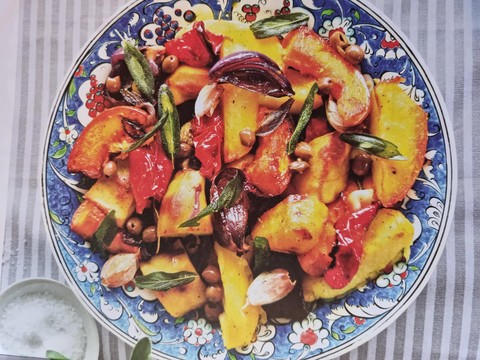
Amongst the more wintry herbs, there are two that are truly rewarding to grow in the home garden or in a patio tub all year round. The sturdy rosemary bush, found in so many urban gardens will give endless pleasure, adding a lovely scent to cooking, both sweet and savoury. And then there’s the much smaller sage bush with leaves that add amazing savoury flavour for a surprising lift to meats and vegetables. Both these herbs are hardy, can be pruned back viciously and have leaves that are far better lightly cooked rather than the fresh raw tastes of their summer companions, chives, basil and parsley.
Sage has become one of my favourites. Don’t be put off by the very strong flavour of those dried sage leaves, packed into small boxes on the supermarket shelves, which can become assertive and dominant in stuffings and casseroles. Using freshly plucked leaves from the bush, especially when young and tender, will make all the difference to your food.
Sage originated in the Mediterranean and on the popular Dalmatian coast bees feast on endless bushes to produce a very special flavoured honey. (Our equivalent here in New Zealand is the lovely wild thyme honey from Central Otago.) The ancient Romans established sage everywhere they travelled, loving its health-giving properties, to aid digestion and prolong youth. In Italy sage is still much loved today, and one of the star recipes of Italian cookery is saltimbocca, fried thin slices of veal wrapped in prosciutto with sage leaves tucked in.
The Italians also sauté fresh sage leaves in butter briefly to make them crisp and sweet to add to all manner of dishes. When I am in a hurry and in need of a tasty lunch I will heat a little oil and butter in a very small frying pan, drop in fresh sage leaves and as they start to sizzle I carefully break two eggs on top of the leaves. I flip the eggs over and cook until almost set and then enjoy a perfect quick meal. Sage fried eggs - so tasty and prepared in less than five minutes.
Fried potatoes with sage is another way to take your cooking up a few notches. Take those beautiful little perla potatoes, rinse them and if they are larger, wash and cut the potatoes in half or into even chunks. Place them in a steamer over boiling water and cook until tender, which should take about 10-12 minutes. Put a little oil and butter into a heavy frying pan and gently heat until the butter is melted. Make sure the potatoes are well drained and dry and add to the pan with a handful of fresh sage leaves. Cook over gentle heat for about 15 minutes, tossing frequently so the potatoes turn golden and the sage leaves become crisp. Season to taste with salt and freshly ground black pepper, and serve hot.
In this easy roast recipe, take advantage of the array of the autumn harvest. A tray filled with delicious sage roasted vegetables makes a lovely meal to accompany steak or baked chicken. To finish the dish you can add anything that takes your fancy such as olives, feta or little cherry tomatoes.
Sage roasted autumn vegetables
- 2 medium agria potatoes
- 2 medium kumara
- ¼ small pumpkin
- 1 medium eggplant
- 2 medium onions
- 1 red sweetie pepper
- 4 cloves garlic
- 1 tbsp extra virgin olive oil
- Salt and pepper
- A large bunch of fresh sage leaves
For the dressing:
2 tsp wholegrain mustard
1 tsp salt
1 lemon, juice and grated zest
1 tbsp maple syrup
Preheat the oven to 190°C
Peel potatoes and kumara carrots and cut lengthwise into quarters.
Peel the pumpkin and cut pieces roughly the same size as the potato pieces.
Slice the eggplant in half and then cut into similar sized pieces.
Peel the onions and cut into quarters, leaving the root end on each piece. Cut the pepper in half, remove the seeds and cut into six pieces.
Peel the garlic cloves and squash them gently.
Put all the vegetables except the pumpkin in a large roasting pan and toss well with four tablespoons of the olive oil and a generous amount of salt and pepper.
Place the pan in oven and roast for about an hour, adding the pumpkin and sage leaves after 20 minutes. Turn the vegetables once or twice, to get nice browning on all sides.
While the vegetables are roasting, whisk together the remaining olive oil, lemon juice, mustard and maple syrup with a little salt.
About ten minutes before the vegetables are ready, scatter over the remaining sage leaves, and continue roasting.
When all is cooking and smelling aromatic, take the pan out and place the vegetables on a serving platter, and pour the dressing over. You can add little cubes of feta, some nice olives or halved cherry tomatoes to add even more interest and flavour, if you want.
This is lovely served warm or can be prepared ahead and served at room temperature.
Serves 6.
7 January 2021
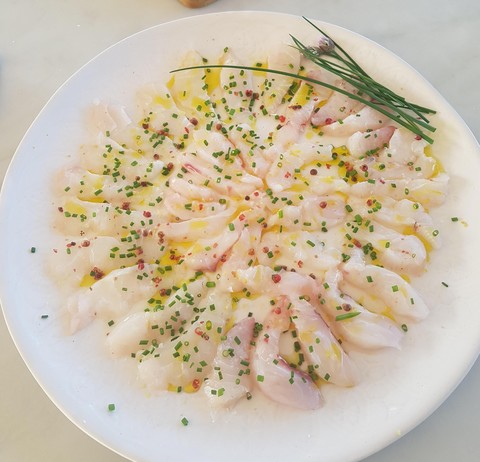
Summer is a time for fun and I am always happy when the weather gods permit my husband to take off in his boat towards Hauturu Island to hopefully and helpfully catch some fresh fish. (Yay for Knowing My Fisherman!)
Yesterday was such a day and he was back in a few hours with his permissible catch of seven snapper – enough to feed a few neighbours and for me to make some tasty ceviche to nibble on while the barbecue did its magic on a sturdy piece of delicious beef prime rib.
I have had a few requests for my very simple recipe for the very fresh snapper so here goes:
*500g of filleted and skinned snapper fillets
*1 very juicy local lime
*flaky sea salt
*small bunch of fresh chives, snipped into tiny pieces
*2 tbsp Lot Eight infused fennel olive oil
*1 tsp pink peppercorns
Using a very sharp knife, slice the ice cold fish thinly and lay out on a white platter.
Grate the lime zest over the fish and then squeeze the lime juice over.
Sprinkle a generous amount of flaky sea salt over the fish.
Scatter the chives and peppercorns evenly over the fish.
Finally drizzle the olive oil over everything and serve at once.
If you want to prepare this ahead (no more than two hours) cover tightly with cling film wrap and refrigerate until serving.
Serves 6 to 8 as a pre-dinner treat.
20 December 2020
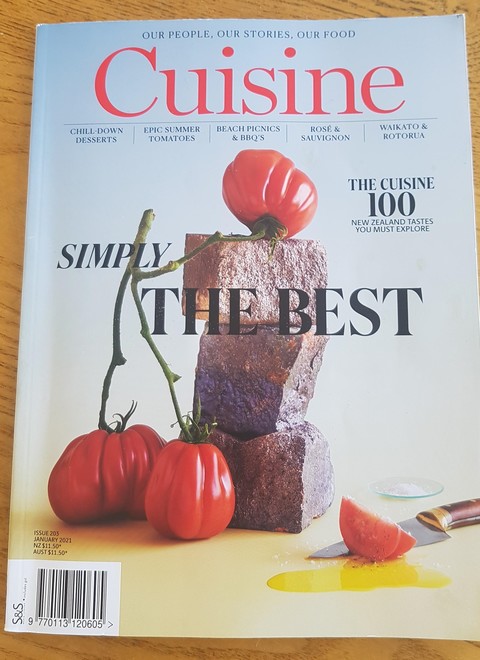
I spent 22 years at Cuisine, happy there until the last year when we had an editor who knew little about wine, less about writing and even less about food and how to cook. In the inevitable clash I lost one the best parts of my life as I was passionate about that magazine. That editor returned to Australia not long after my departure and the magazine was never quite the same as in its early heyday when Ms J Dalzell was owner, publisher and editor.
Eleven years have passed and I can confidently say that the latest issue is THE BEST magazine published since I left. Not only is the cover bold and up there with many amazing covers of the past (remember the tag line – We Do Amazing Things) but the content nails the world of the food lover. The recipes are exactly what we all need for the summer – simple yet sophisticated and original without being too clever. I can almost feel myself wanting to dip my fingers into the stunning photographs and lick them clean. I can’t wait to cook Asher Boot’s roast chook with sage and onion stuffing (it’s that spiced butter to slather on after the chook is cooked that really appeals), or Ginny Grant’s clever tomato tonnato, or Emma Galloway’s mango and lime crumble cake (perfect in the tin for a picnic) and every single dish from Sean Connolly’s new Esther restaurant. Everything looks pretty, easy, and nothing is ‘cheffy.’
But there’s far more to food than recipes. Cuisine is now in the same position as the old days. The editor, Kelli Brett is co-owner, and publisher too. She is smart and sassy (even called her publishing company Slick & Sassy Media), she has that boldness that many Australians have, but most importantly she is totally passionate about New Zealand and our good food. In Cuisine's 33 year history no editor has been quite as obsessed about fabulous food as Kelli.
So not only is this a magazine to cook from, it’s got a heap of reading to do too. ‘The Cuisine 100 Tastes of New Zealand’ is breath taking in its accuracy, its innovation and its deep dive into all manner of things connected to food from cheeses, oysters, meats, ice creams and other favourites to books, shops, plates, drinks and more. (I am rather embarrassed to write my latest book is there – Always Delicious. I nearly fell over and broke my wrist again when I spotted that in the list. In very distinguished company too, with Hiakai and Eat Up New Zealand.)
The Crispy Bites is jam packed with restaurant news, the reviews are delivered in the casual get-to-know-this-restaurant style that does not judge but instead tells you exactly why you need to get to these places, and there’s a great guide to summer drinking with the best sauvignon blanc and rosé wines that will be perfect for my summer. And right at the end is a straight from the heart essay from Sean Golding, one of the owners of the excellent Shepherd restaurant in Wellington. He explains exactly why he and co-owner Shepherd Elliot refigured their restaurant and raised prices but never lost a customer. The true price of food is in the ingredients and that without profits, a business, or a grower, or a supplier, is not sustainable. Plenty of food – for thought too.
I defy any person who considers themselves well steeped in our New Zealand food lore and the culinary scene to read every word in this issue and tell me there’s not something new they have learned. Go on. Do it. There’s your challenge.
19 November 2020
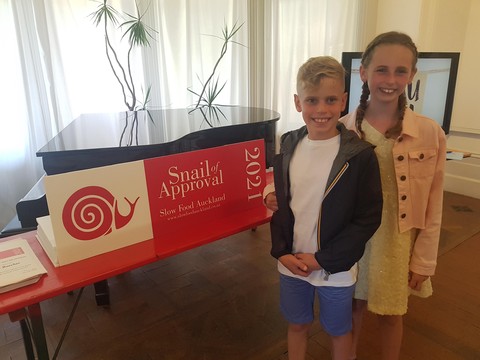
Auckland is firmly claiming a new designation, City of Snails. Some unkind folk have called, for good reason, this to be a City of Cones – not because of the wonderful volcanic maunga that dot the city – but due to the everlasting use of road cones that inevitably bring the city traffic to a snail’s pace while just everything is being rebuilt and reorganised.
Regardless of the traffic snarlups there’s another great snail pace reason to claim this the City of Snails. There’s so much renewed interest in food, there are so many wonderful new restaurants opening despite the curse of covid, and now the city has a bunch of local businesses who have recently been awarded the Slow Food ‘Snail of Approval’ certificate.
The Slow Food movement is worldwide, started last century in Turin by an Italian food aficionado Carlo Petrini, outraged by McDonalds fast food outlets opening in his country. He aimed to change the attitude of the world through food, and to celebrate and treasure the love of food cultures, rituals and traditions. There are now thousands of members all over the world and events, programmes and simple gatherings to follow his lead. One of the internationally recognised Slow Food programmes is the Snail of Approval designation for small businesses that exhibit passion for everything local, that celebrate locally grown and produced food that is good, clean and fair, and to distinguish intent, passion, and effort rather than perfection.
So congratulations to the following Auckland Small Businesses with the Slow Food Snail of Approval:
• A Lady Butcher
•
• Brick Bay Wines
•
• Cazador
•
• Clevedon Buffalo
•
• Curious Croppers
•
• Earthbound Honey
•
• Foundry Chocolate
•
• Giapo
•
• Hāngi Master
•
• Kelmarna Gardens
•
• Ooooby
•
• Pasta & Cuore
•
• Rangihoua Estate
•
• Scarecrow
A terrific list that is really assisting Auckland in its position as culinary capital of Aotearoa.
Please get out, support and buy from these fabulous, conscientious people.
Pic above. The excited Giapo ice cream kids - next generation Slow Food fans.
15 October 2020
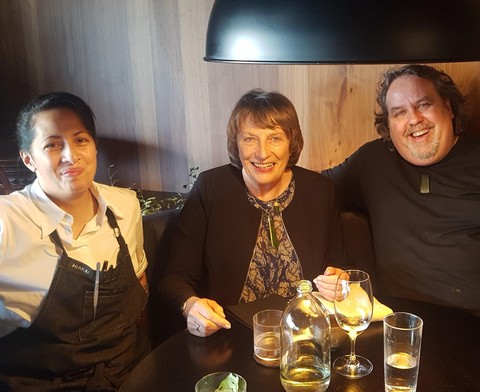
On a whim I booked tickets to a Visa Wellington On A Plate event. I was travelling there to speak at the Farmers’ Market conference so this rather special lunch the day before and the amazing Van Gogh on a starry night (well worth the visit) really appealed.
The lunch was at New Zealand’s restaurant of the minute, Hiakai. In stunning surroundings our newest food hero, Monique Fiso, is knocking diners out with her amazing use of indigenous ingredients and clever, almost intellectual, approach to cuisine. She wanted to pay tribute to her culinary mentor, the legendary chef Martin Bosley with a collaborative menu that reexamined his daring ground-breaking dishes at his eponymous Martin Bosley’s in the Port Nicholson Yacht Club and at Brasserie Flipp. Adding, of course, touches of the food she’s developed for Hiakai.
It was an afternoon of memories, excellent food and fun for the thirty guests. As always the menu started with generous snacks. A lovely soft bread roll with Hiakai’s already famous tītī butter and a fabulous gin cocktail was followed by clever plays on the Bosley chicken liver parfait, essential just shucked oysters in the shell with salmon roe, a stunning tomato tart, the cleverest rendition of chips and dip ever invented in a kitchen, and meaty rib seasoned with local herbs and spices.
Then came the serious courses. ATOM proved to be asparagus, tomato jelly and a perfect icy sorbet, (somewhat ruined for me by an “orange” wine), then a delicate cedar planked salmon which was always, always, a best seller at MB. Next up the perfect piece of beef that literally melted in my mouth with an accompanying mushroom pie and various sauces to enhance the wonderful Escarpment pinot noir and finally a stunning plate of desserts that included MB jelly, a Milo chocolate bomb from Hiakai and other brilliant treats from the kitchen that were sweet but not sugary.
What was so special apart from the reinterpretation of food memories and the spirited play was to see the respect the Hiakai staff had for Martin Bosley. They all gathered around him at every opportunity and hung on every word of this absolute taonga of a chef. The food was not complex, standing in the great space that lies between then and now. Bosley’s avant garde approach to the culinary scene of Aotearoa and his influence on a generation of its chefs has been considerable. It was a total privilege to observe the baton being passed to Fiso whom I have no doubt will be the biggest influence on the next generation.
11 September 2020
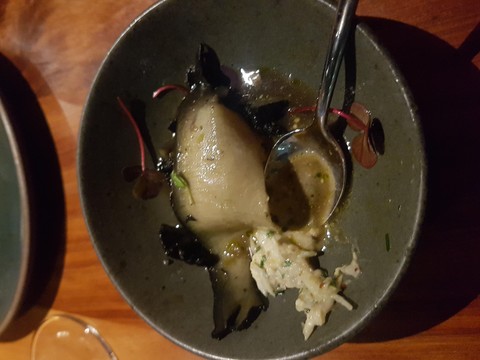
For years everyone in the food industry from chefs to food writers have struggled with the concept of a unique and identifiable NZ cuisine. Although we serve traditional roasts, whip up cream laden pavlovas, eat Weetbix or muesli for breakfast, and fill our plates with meat and three vegies that way of eating is mostly often emulating the very British fare that early settlers ate. Or we mumble about hāngi feasts without knowing and understanding the layers of rich tradition involved.
I have often puzzled about this, written for various publications and spoken at length in discussions, workshops and conversations. But not in a million years did I think that this difficult year, the Year of Covid, would be the year that finally the clues and stars to defining a true and unique cuisine for Aotearoa align.
Like many countries with their own admirable and recognisable cuisine, the focus is ingredients, shaped in the kitchens of leading chefs. We have being hiding the trump card in our deck, the indigenous fare of Aotearoa, for too long. The sheer brilliance of a small coterie of chefs are now proudly putting these ingredients on their menus, cooking them selectively with the influences and style they’ve been exposed to in the work around the planet.
Monique Fiso is not the first to track down the natural flora and fauna that is now showing up on menus, but it is her seminal work in her Wellington restaurant Hiakai, and the just released this week book of the same name that has finally made it to the mainstream. As I stated in my review of her book, originally written for the new website ketebooks.co.nz (see the post below,) I sincerely hope this book appears on every good chef’s shelf and is used frequently.
Over the past two years Vaughan Mabee has been doing some splendid cooking at Amisfield in Central Otago and most of his dishes could only be described as New Zealand on a Plate. His artistry plays homage to much of the traditional taonga and his foraging and hunting is noteworthy. Ben Bayly has opened Ahi in Auckland’s new Commercial Bay and his menu reflects traditional cooking styles and the very best ingredients that we grow or produce. In my local area, Chef Will Michell at the Sawmill Brewery’s Smoko Room is cooking some stunning food that shows the influence of a stint in the Hiakai kitchen and makes terrific use of some of our lesser known kaimoana. In Dunedin, Hannes Bareiter is sourcing wonderful indigenous ingredients in his recently opened restaurant, appropriately named Titi. And of course, Monique's work at Hiakai is outstanding in every way and true to this newly recognised cuisine.
We can also look at other recent openings and see the respect being paid to our brilliant ingredients and the adoption of much of the traditions of Māori cooking, done with subtlety, empathy and care. We have myriad chefs who have grown up elsewhere, and they’re keen to be part of this new identifiable direction. Their traditions, whether they’re Japanese, Korean, European or Middle-eastern, melded with our amazing flavourful food will take the cuisine of Aotearoa on an exciting path in the next few years. I can’t wait.
(Dish is paua and kahawai at Ahi)
11 September 2020
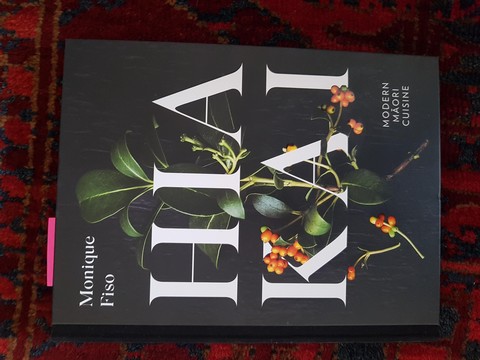
Recently there’s been much discussion in erudite food circles about the New Zealand food story as writers, critics and chefs attempt to identify what our cuisine looks like to the world, and what could be claimed as distinctive about the way we choose what to cook and how we prepare it. We have become the masters of fusion cuisine as waves of immigrants from all over the world change what we eat (Auckland alone has more than 80 restaurants offering menus of differing ethnicities.) We’ve adapted, embraced and incorporated plenty of new ideas into a diet that for many years was essentially based on early colonial fare.
There was, however, a missing factor that can truly be claimed as unique to Aotearoa; the tradition, ingredients and methods of Māori food. It has been exciting, and not before time, to observe the awakening of chefs and cooks to the possibility of incorporating native foods into their menus. But it has taken a visionary young woman chef, Monique Fiso, passionate about her heritage (Ngā Rauru, Ngāti Ruanui) to immerse herself in research, to reimagine and present traditional Māori food which she does in her stunning Wellington restaurant, Hiakai (hungry or having a desire for food.)
Her book, Hiakai, may be the singularly most important food book ever published in New Zealand with a deep dive into everything that plays into modern Māori food. Fiso’s painstaking investigation into traditions and ingredients gathered information from numerous sources in libraries and collections, here and abroad. Māori traditionally told their stories and history orally, handing it down through generations. This is the first time this valuable information has been recorded and crammed into one volume. For the mind-boggling ambitious task, which encompasses Māori history, mythology, tikanga (customs) and indigenous ingredients, Fiso was assisted by an associate professor of food culture, Tracy Berno and local food writer Lucy Corry.
The book has three major sections. The all-important section of stories, mythology and history is followed by a comprehensive explanation of all past and present indigenous ingredients, from the earth, land and ocean. Finally there’s a taste of the restaurant fare that diners have to book months ahead to try at Hiakai.
The recipes are brilliant and joyful, delving into previously unknown territory to encompass indigenous ingredients that can be sourced today, yet no doubt with much effort. Fiso’s extensive acumen for foraging and fermentation is evident but with few recipes that other cooks would even attempt.
There’s no doubt she is leading the way for New Zealand chefs to embrace Māori cuisine and ingredients, and hopefully many (or all) will see this book as a highly desirable reference for their own kitchens.
The photographs by Amber Jayne Bain and Manja Wachsmuth too are stunning. Fiso’s personality and focus are well captured as she ventures into bush and shoreline on foraging trips, works with her staff, and cooks for the sophisticated and receptive audience at Hiakai.
Hiakai is serious, ground-breaking and a genuine taonga.
This review was first published in ketebooks.co.nz
7 September 2020
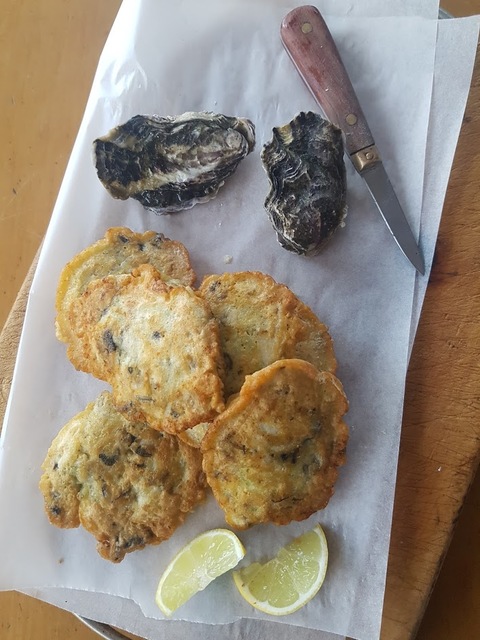
We’ve been urged to buy local, and in a food producing nation like ours, it would be even better if that message was strongly ‘Buy Local, Eat Local.’ Plenty of great ingredients grow and food products are manufactured in the Mahurangi region, so we can feast on fresh, tasty and healthy fare that will get the local tick.
I love it that we have local oysters that can be bought direct from the farm, and personally can never get enough of these delicacies, freshly shucked and eaten straight from the shell with not much more than a squeeze of local lemon or lime.
At this time of the year, when winter is almost behind us, some of the sweetest oysters of the year are being harvested. While we’re used to savoury Bluffies with a season that runs from March to August, we need to recognise our own local Pacific oysters, growing quietly in the Mahurangi and Kaipara harbours.
The subtlety of taste of each oyster varies according to where the oysters are from.
I spoke to Andrew and Lisa Hay of Mahurangi Oysters, who sell most of their harvest to restaurants around New Zealand, about the secret lives of these shellfish. Oysters are filter feeders, with each oyster processing 18 litres of seawater per hour as they feast on the algae. This helps to clean the environment, and Ministry of Primary Industry guidelines dictate that if there’s more than 25mls of rain over a 24 hour period, the farms must close for three days to ensure no runoff from the land contaminates the oysters.
In the hottest summer months, after the oysters have spawned (each oyster can create up to 10 million eggs) they are thin and wan, but begin to build up the creamy fat that’s much prized by oyster lovers. Oysters are affected by the moon and vary between being crisp when the moon has waned, while showing the most creaminess as they build up to full moon when the tides are highest.
If you’re keen to seek out local oysters right now, when they are truly at their best, you can order online from Mahurangi Oysters, head to the Oyster Shed on the Leigh Rd, or purchase Orata Marine Oysters at the Matakana Farmers Market in the shell, half shell or little pottles. One pottle or 18 freshly shucked oysters are perfect for this delicious recipe.
OYSTER FRITTERS
- 1 small onion, finely chopped
- 4 tbsps butter
- 2 large fresh eggs
- 3 tbsps self-raising flour
- 18 shucked oysters, chopped
- Salt and pepper
- 1 lime, finely grated zest only
Place the onion in a bowl with one tablespoon of the butter and cook for 2 minutes in a microwave until soft. Beat the eggs in another bowl and whisk in the flour to make a smooth stiff batter.
Stir in the onion, oysters, some salt and pepper and the lime zest and mix well.
Heat a heavy frying pan and melt half the butter. Drop large tablespoons of the oyster batter into the pan, and cook four or five at a time over gentle heat for 2 minutes until golden, then flip over and cook the other side. Stack the fritters up on baking paper and keep warm while you cook the next batch with a little extra butter.
Makes 8-10 fritters.
- This was first published in Mahurangi Matters
7 September 2020
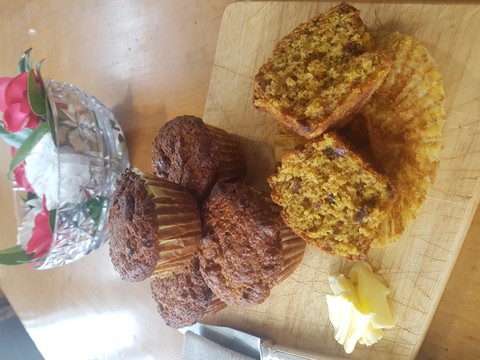
We’re so lucky in the north of New Zealand to have a temperate climate and plenty of keen horticulturalists and orchardists. Each season brings with it an array of sweet, fresh, seasonal fruit that we can feast on. So for my new monthly column in The Hobson for August, my thoughts turned to my favourite of all fruit – NZ grown oranges which had just begun their sweet but short season.
The citrus season starts with sweet little mandarins, but those first loose skinned, seedless varieties are over quickly. They’re followed by limes, lemons, grapefruit, tangelos and other varieties of mandarins. The citrus fruit I have encountered this season has been far juicier and far sweeter than any other year in memory. I suspect it was our long hot summer followed by late season rain that allowed to fruit to swell at exactly the right time.
Early July brought the start of New Zealand oranges, the absolute stars of our citrus season. Both navel and Valencia varieties can be found now, and both are perfect for juicing and eating. The navel orange can be identified by the little navel-like dimple at its base and slightly pebbly skin. It is easy to peel. It’s usually seedless, a rich orange colour and is deliciously sweet. The Valencia is paler, has a smooth skin and is the perfect orange for juicing.
Each of my columns in The Hobson includes a recipe, and I immediately thought of this one, an oldie but a goody, based on an American recipe I had collected back in the 80s on a trip to San Francisco. It is a wonderfully fragrant, moist muffin. It’s interesting when you write recipes, as you never quite know who will love it, adopt it and make it their own. The feedback has been sensational – so much so that I broadcast it when I was talking to Jess Mulligan on RNZ afternoons a week or two ago. Everywhere I go I am told what a success it is so here you go … you will need to buy about three fresh New Zealand grown oranges as one whole orange, (skin, flesh and all) is used in the muffin and there’s extra orange juice that makes the muffin batter truly moist.
WHOLE ORANGE AND DATE MUFFINS
Preheat the oven to 200°C. Butter a 12 cup muffin tray.
Sift 210g flour, 1 teaspoon each of baking powder, baking soda and salt together and put aside.
Pulse 100g pitted dates in a food processor with 50g brown sugar until the dates are coarsely chopped. Wash 1 whole orange, cut into 8-10 pieces and add this to the food processor, pulsing until all is finely chopped. Add 100g brown sugar, 110g chopped butter, 1 large egg and ½ cup orange juice and blend well.
Add the sifted ingredients and pulse until they just mixed, taking care not to over process.
Divide the dough among the muffin cups and bake until firm to the touch and lightly browned. (About 15 minutes.)
Make 12 muffins. Serve warm with extra butter.
7 September 2020
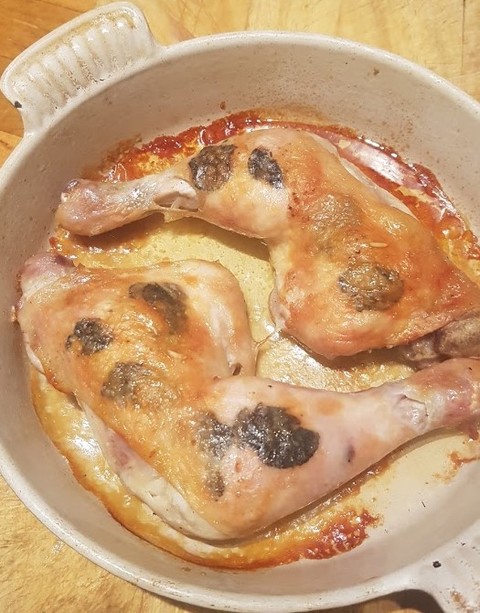
I am a bit tardy in posting this but cannot overlook it. I was gifted a gorgeous truffle from Winter Truffles in the Waikato last month – the very first truffle I have ever had to play with.
More years ago than I care to reveal I was asked to invest in a truffiere north of Auckland. I didn’t have much money to fling around so I declined to join this bold initiative and often wondered if the investment reaped the promised rewards. At that time Dr Ian Hall was showing the first success in NZ with his Gisborne truffiere, but then the truffle scene went rather quiet. A few years later I visited Gareth Renowden in north Canterbury and watched his gorgeous truffle dog Rosie uncover a couple of aromatic black truffles underneath the trees he’d specially planted and infected with truffle spore. Chefs in the know have bought truffles for their restaurants from different suppliers lik3e Gareth over the past decade and it seems the NZ Truffle Assn has a network of successful growers throughout the country.
So what did I do with this little piece of black magic that originated in Perigord in southern France? As you can see in the above photo, I gently prised the skin from a pair of Bostock chicken marylands and inserted paper thin slices of truffle along with some butter next to the flesh. I roasted the chicken and it has to be the most successful, tasty chicken we have eaten this year. Earthy, rich with a distinctive aroma that’s not like any other.
I still had half of my truffle so that went onto some pasta the next night, also thinly shaved and tossed with plenty of butter and some fabulous Meyer grated aged gouda cheese (also from the Waikato). I am eagerly awaiting next winter when the truffles appear again. Luxury personified.









